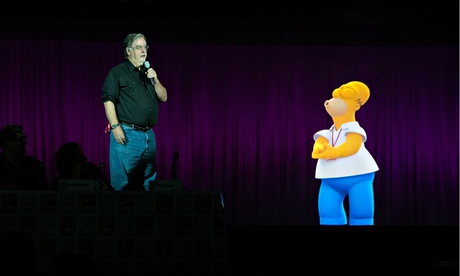
The Simpsons turns 25 this Christmas. The animated show has brought us the exploits of Homer, Marge, Bart, Lisa and Maggie for a quarter of a century. That's a staggering achievement, and to help mark the occasion Simpsons creator Matt Groening hosted a panel at the San Diego Comic-Con at which he introduced a very special guest – Homer Simpson himself.
This Homer was a 6ft tall 3D hologram, animated by The Simpsons artists, voiced by Dan Castellaneta and brought to life by our team at psLIVE. As an experiential agency, our job is to help brands realise their creative ideas in the physical world, but bringing Homer Simpson to life in the real world presented a very distinct challenge.
Holograms have been used over the past few years to bring iconic musicians like Tupac Shakur and Michael Jackson back to the stage, but Homer needed to be able to chat with Groening, looking, sounding and feeling entirely lifelike for the 6,000 people attending the session. To achieve this we designed a sound stage using specially placed curtains to hide projection equipment, and carefully choreographed Groening's movements with a well-rehearsed script to give the illusion he was having a live conversation with Homer.
For Springfield's nuclear dad, we looked to the distant past – a 16th century theatre trick called Pepper's Ghost.
The technique involves using a reflective surface positioned at a specific angle to the audience. We used a taught foil screen, a bit like cling film, though much more durable, which was stretched across the diagonal plane to the audience. Two 3D projectors were suspended in the rigging to display an image directly onto the foil screen, which reflected into the audience and created the illusion of Homer being there.
This sort of illusion is not without its difficulties. A major problem is light pollution. Any light contaminating the environment can seriously disrupt the illusion, which meant that in the burning San Diego sun we had to create a fully darkened auditorium by blacking out all the windows. Likewise we had to be mindful of flash photography, as the flash could bounce off the foil screen and ruin the illusion. That's no mean feat with 6,000 Comic-Con attendees in the audience.
Light pollution is what, unfortunately, limits this sort of experiential activity. Companies looking at using holograms in experiential activity need to ensure they have an extremely controlled environment to successfully achieve and sustain the effect. This also means that experiential's most natural environment – the middle of day in an iconic location – is unfortunately out of the question.
However, experiential agencies should be excited about the prospect of using holograms in their campaigns. They're a great way to bring a fictional or digital property into the real world and generate massive exposure for brands. They're also a uniquely experiential feature – a hologram is an event to be experienced by those in the room, and to take that unique experience away with them.
To use holograms effectively agencies need a few things: a darkened, closely controlled environment where they're able to focus the audience's attention on a single point, an audience willing to play along with the no cameras rule and, most importantly, a beloved 25-year-old yellow cartoon character.
Michael Brown is the managing director at psLIVE
Read more stories like this:
• Social media strategy: seven lessons for engaging with your fanbase
• Building a Facebook community will never trump a newsletter you own
To get weekly news analysis, job alerts and event notifications direct to your inbox, sign up free for Media Network membership.
All Guardian Media Network content is editorially independent except for pieces labelled 'Advertisement feature'. Find out more here.

